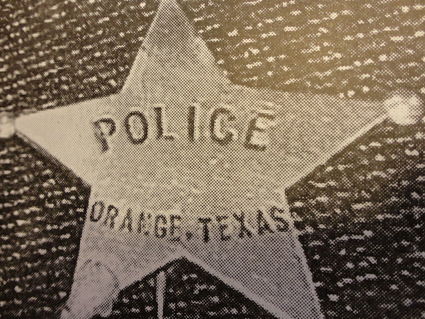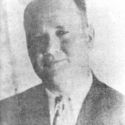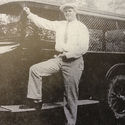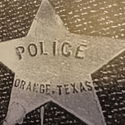Three OPD officers killed over the decades
Last updated 5/14/2013 at Noon
This week across the country police are taking time to reflect on their fellow brethren who have lost their lives in the line of duty.
In 1962, President John F. Kennedy proclaimed May 15th as National Peace Officers Memorial Day and the calendar week in which May 15th falls, as National Police Week. Established by a joint resolution of Congress in 1962, National Police Week pays special recognition to those law enforcement officers who have lost their lives in the line of duty for the safety and protection of others.
In Orange, there have been three officers with the Orange Police Department who have lost their lives in the line of duty. They are Johnny Godwin, Ed O’Reilly and Danny Gray.
The Orange Police Department was formed in August 1914. Citizens had voted for a new city charter and had the authority from the state to set ordinances. Orange was formerly Madison, but when Texas became part of the United States in 1849, the state legislature renamed the town Orange.
However, Orange did not go without law enforcement from the early days until 1914. In the early days, records reflect the local sheriff ran the town with the help of local citizens.
Orange was fist settled in the 1830s and had a reputation for being a “rough town.” Initially, the town had its’ share of lumberjacks, ship-builders, sawmill workers and industrial workers who for the most part, like to drink and gamble. These kind of activities often lead to problems such as fighting and other violence. This continued through the 1960s when drug related problems reared their ugly head and burglaries, thefts and robberies continued to escalate.
Before the 1890s, justice did not always involve a courtroom. Some criminals met their fate with “Judge Lynch.”
Angry mobs would sometimes hang criminals by the neck on the long reaching limbs of the “hanging tree.” The tree was a large oak tree located at the corner of Fourth and Front Streets. According to history reports, the mobs would shoot at the tree while the body of criminal swung from the tree. The tree is said to have died over the years from “lead poisoning” from all the bullets which had been sprayed by the lynchers.
The city jail at the time was close to the tree. They were called “calabooses” and were first built in August 1892. They were small, wooden buildings on piers near the banks of the Sabine River where Ochiltree Park is currently located. Until the 1945, calabooses remained as the local jails.
By the end of 1914, the Board of City Commissioners passed their first ordinance which referred to regulating the traffic and passage on the streets. The maximum speed limit was 12 mph and drivers were not allowed to turn a corner faster than 6 mph, whether in a motorized vehicle or horse and buggy.
The salary for police officers in 1918 was $100 per month but a year later, their salary would increase $25.
By 1929, they would have their first vehicle. For $600 a five passenger Chevrolet “touring car” was purchased.
Commissioners, during their meetings in 1929 talked of the necessity of a “steel cage” for criminals, but the stock market crash and the Great Depression would strike. They would have to wait many more years.
In August 1945, city leaders finally got what they had wanted when the carriage house behind the building which is where the Orange City hall is currently located, became the city jail and steel bars were installed.
The first officer to be killed in the line of duty in Orange was Police Chief Ed O’Reilly.
The young O’Reilly began his life in Orange by working at the shipyards. He left to join the war efforts by enlisting in the Navy. According to archives, following his return from the war, he worked as a special officer for a refining company and the railroad before being called to work as a police officer.
O’Reilly also made two unsuccessful attempts at running for sheriff. However, on June 8, 1931, he was appointed to the local police force. Just over a year later, he was appointed as the new police chief and took office in August 1932.
During this time period, he was essentially the police force during the day. There two officers assigned to night duty.
The first issue he faced was the growing traffic problems. But, this would only be the one of many problems to come.
The First Baptist Church pastor, Reverend Edgar Eskridge had baptized O’Reilly two years before the murder, but would also be the person who would later kill him even though the two were thought to be good friends. The pair had worked together on law enforcement matters and had even traveled together.
But, the reverend developed a different agenda and began carrying guns to the pulpit. Eskridge was also telling the locals he was a commissioned law enforcement officer with Newton County. Eskridge, with guns blazing, vowed to clean up the crime in Orange and not just from his one-of-a-kind sermons.
Eskridge went as far as to conduct a raid on the Silver Slipper in Prairie View, now known as Bridge City. The infamous supper club had mirrors on the walls and fancy linens on the tables which catered to gamblers.
According to historians, Eskridge brandished a “Ranger’s badge” and was accompanied by a small group of men during the raid.
Within a few hours, Eskridge would be at the pulpit in front of his congregation vowing their would be violence in the city “very soon.”
Tension continued to build and Eskridge was quickly becoming a controversial figure in town. O’Reilly was forced to disarm the pastor who many believed was dangerous and out of control. O’Reilly had learned the preacher was not a commissioned officer and therefore he was arrested for impersonating an officer.
O’Reilly took Eskridge before a judge, but he released him because of his position in the community.
Church members and people around town talked about the fact Eskridge seemed upset and agitated. A local gas station attendant who knew Eskridge reported he could tell, “there was going to be trouble.”
O’Reilly was standing outside the Ingram Cafe on May 29, 1935, located on the southwest corner of Fifth and Main Streets, which is now the Lutcher Theater parking lot. He was talking to a friend when Eskridge drove by and shot at the police chief. O’Reilly had just celebrated his 41st birthday a few days before when the buckshot pierced his skull and he died.
A short while later, Eskridge, in his tan Oldsmobile coupe went up Green Avenue and crossed the Sabine River Bridge to where he would surrender to Beauregard Parish officers in Deridder, La.
The congregation of the First Baptist Church met that night to draw up resolutions of condolence to O’Reilly’s wife and daughter. They also prepared an expression of sympathy for Mrs. Eskridge.
Funeral services for O’Reilly were held the following day at his residence located at 808 15th Street.
Eskridge was held in jail until his trial which had been moved to Houston on a change of venue. In June 1936, he was found guilty of murder. He was sentenced to five years in prison. However, he was released from prison after onl y serving three years and 10 months of his sentence.
The city commission met May 31 to appoint John D. Godwin Jr., 31 years old, as acting police chief. But, less than four months later, he too would be killed in the line of duty.
Godwin was born in 1904 in Louisiana, but lived most of his life in Orange. He was said to be “everyone’s friend.”
In the early years, he worked for a local produce company making deliveries. By 1924 Godwin took a job working for an oil company in the geophysical department. This job required travel. He married the love of his life, Robbie, in 1926 and really began to miss Orange. They later had two children.
Godwin joined the Orange police department as a night policeman. He had only been on the force two months when he was promoted to acting police chief.
Godwin had just dropped off his family at their house on 7th Street when a chain of events would lead to his death.
He was with another officer, George LaFitte, when they received information about two fugitives who had assaulted a cab driver before stealing his cab.
At about 9:30 p.m., they spotted what they believed to be the stolen cab.
The vehicle was driven by Cylde Dawson and the passenger was B.F. Thompson.
The officers stopped the cab on Green Avenue between 3rd and 4th Streets.
Lafitte had his shotgun pointed at Thompson while Godwin confronted Dawson.
The events what happened next are unclear, but Godwin was shot in the abdomen.
Godwin was transferred to the local hospital where he died the following day.
He was buried at the foot of the gravesite where O’Reilly was buried just months before.
Dawson fled the scene and kidnapped two local people before being apprehended in Louisiana. He was sentenced to life in prison on October 5, 1935.
In 2001, Godwin’s name was submitted to the Texas Commission on Law Enforcement Officer’s memorial and to the National Law Enforcement Officers Memorial in Washington, D.C. along with the other officers who were killed in the line of duty.
The photographs of the three officers who will killed in the line of duty in Orange, now proudly hang in the lobby of the Orange Police Department to be seen by all visitors.
Editor’s Note: Part two of this story and the life of the third officer, Danny Gray, who was killed in the line of duty will run in the May 22 edition.


















Reader Comments(0)